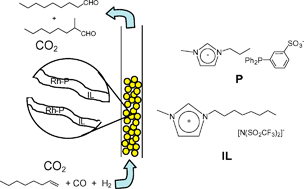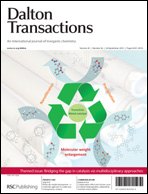A supported ionic liquid phase (SILP) catalyst prepared from [PrMIM][Ph2P(3-C6H4SO3)] (PrMIM = 1-propyl-3-methylimidazolium), [Rh(CO)2(acac)] (acacH = 2,4-pentanedione) [OctMIM]NTf2 (OctMIM = 1-n-octyl-3-methylimidazolium, Tf = CF3SO2) and microporous silica has been used for the continuous flow hydroformylation of 1-octene in the presence of compressed CO2. Statistical experimental design was used to show that the reaction rate is neither much affected by the film thickness (IL loading) nor by the syngas:substrate ratio. However, a factor-dependent interaction between the syngas:substrate ratio and film thickness on the reaction rate was revealed. Increasing the substrate flow led to increased reaction rates but lower overall yields. One of the most important parameters proved to be the phase behaviour of the mobile phase, which was studied by varying the reaction pressure. At low CO2 pressures or when N2 was used instead of CO2 rates were low because of poor gas diffusion to the catalytic sites in the SILP. Furthermore, leaching of IL and Rh was high because the substrate is liquid and the IL had been designed to dissolve in it. As the CO2 pressure was increased, the reaction rate increased and the IL and Rh leaching were reduced, because an expanded liquid phase developed. Due to its lower viscosity the expanded liquid allows better transport of gases to the catalyst and is a poorer solvent for the IL and the catalyst because of its reduced polarity. Above 100 bar (close to the transition to a single phase at 106 bar), the rate of reaction dropped again with increasing pressure because the flowing phase becomes a better and better solvent for the alkene, reducing its partitioning into the IL film. Under optimised conditions, the catalyst was shown to be stable over at least 40 h of continuous catalysis with a steady state turnover frequency (TOF, mol product (mol Rh)−1) of 500 h−1 at low Rh leaching (0.2 ppm). The selectivity of the catalyst was not much affected by the variation of process parameters. The linear:branched (l:b) ratios were ca. 3, similar to that obtained using the very same catalyst in conventional organic solvents.

You have access to this article
 Please wait while we load your content...
Something went wrong. Try again?
Please wait while we load your content...
Something went wrong. Try again?


 Please wait while we load your content...
Please wait while we load your content...